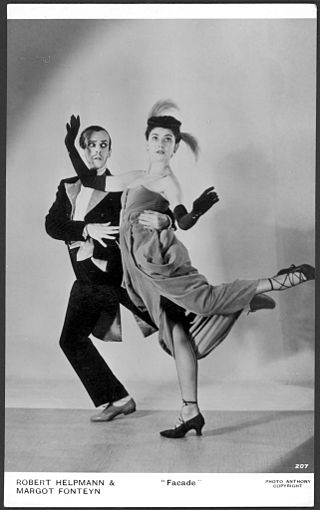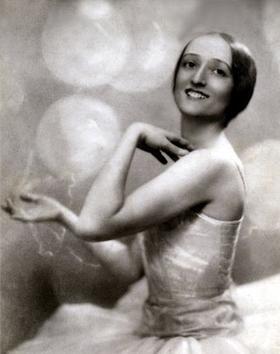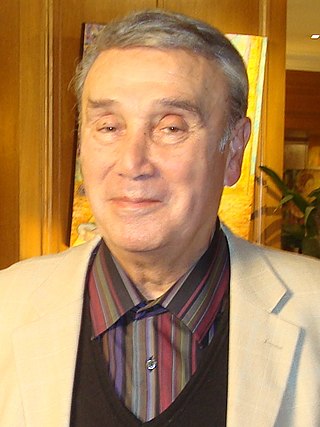External links
- Josef Weinberger: The Creation of The Merry Widow Ballet
- Ronald Hynd's oral history interview in the Rambert Archive
Ronald Hynd OBE (born 22 April 1931) is an English choreographer, and in his youth was a ballet dancer.
In the Royal Ballet in the late 1940s he began to dance with Annette Page, whom he later married. Page died on 4 December 2017. [1] They have a daughter, Louise. [2]
Ballets Hynd has choreographed include The Merry Widow in 1975, [3] and the ballet Charlotte Brontë for the Royal Ballet Touring Company in 1974. [4] He recreated the nineteenth-century ballet Papillon [5] in 1979 [6] and created The Hunchback of Notre-Dame ballet in 1988, [6] both for the Houston Ballet. His version of The Nutcracker , produced by the London Festival Ballet in 1976, added a love story to the traditional tale by giving the heroine an older sister who falls in love with Dr. Drosselmeyer's nephew against her parents' wishes. [7] He also choreographed for companies such as American Ballet Theatre, Ballet West, and Tulsa Theatre Ballet. [8]

Sadler's Wells Theatre is a London performing arts venue, located in Rosebery Avenue, Islington. The present-day theatre is the sixth on the site. Sadler's Wells grew out of a late 17th-century pleasure garden and was opened as a theatre building in the 1680s.

Yvonne Georgi was a German dancer, choreographer and ballet mistress. She was known for her comedic talents and her extraordinary jumping ability. In her roles as a dancer, choreographer, and ballet mistress, she was an influential figure in dance for decades.

Louis Pécour was a French dancer and choreographer. He is most well known for his work with the Académie Royale de Musique.

Katti Lanner was a Viennese ballet dancer, choreographer, and ballet mistress who found fame in Germany and England, where she staged many productions at the Empire Theatre in London.
Wayne Eagling is a Canadian ballet dancer, now retired. After more than twenty years as a popular member of The Royal Ballet in London, he became well known as an international choreographer and company director.
Julia Farron was an English ballerina, best known as one of the earliest and all-time youngest members of The Royal Ballet, the leading ballet company based at the Royal Opera House in Covent Garden, London.
Nina Aleksandrovna Anisimova was a Soviet dancer and choreographer.

Antonio Ruiz Soler, was a Spanish flamenco dancer, choreographer and dance director. He was professionally known as Antonio or Antonio el Bailarín. With Rosario he had a partnership which lasted from 1928 until 1952 and which became world-famous. They were billed as Rosario y Antonio.
Annette Page was an English ballerina. She was a principal dancer with the Royal Ballet, and was usually partnered onstage by her husband, Ronald Hynd.

Façade is a ballet by Frederick Ashton, to the music of William Walton; it is a balletic interpretation of items from Façade – an Entertainment (1923) by Walton and Edith Sitwell. The ballet was first given by the Camargo Society at the Cambridge Theatre, on 26 April 1931. It has been regularly revived and restaged all over the world.

Margaret Craske was a British ballet dancer, choreographer and teacher of ballet.

Dinna Bjørn is a Danish ballet dancer and choreographer. She has specialized dancing and directing the ballets of August Bournonville. Bjørn has also created five Hans Christian Andersen ballets for the Pantomime Theatre in Copenhagen's Tivoli.

Pierre Lacotte was a French ballet dancer, choreographer, teacher, and company director. He specialised in the reconstruction of lost choreographies of romantic ballets.
Mam'zelle Angot is a one-act ballet in three scenes. The choreography and libretto are by Léonide Massine; the music is by Charles Lecocq. The plot is broadly based on Lecocq's 1872 opéra bouffe, La fille de Madame Angot.
Designs with Strings, also Designs for Strings, is a ballet choreographed by John Taras to music from the second movement of Tschaikovsky's Trio in A minor. It was first performed on 6 February 1948 in Edinburgh by the Metropolitan Ballet.
Five Brahms Waltzes in the Manner of Isadora Duncan is a ballet solo choreographed by Frederick Ashton to music by Johannes Brahms, inspired by Isadora Duncan and created for Lynn Seymour. The first version, under the title Brahms Waltz, used only Brahms' Op. 39, No. 15, and premiered on 22 June 1975, at the Hamburg State Opera. The expanded version, which featured more Brahms waltzes, premiered on 15 June 1976, during Ballet Rambert's 50th anniversary gala, at the Sadler's Wells Theatre, London, and is dedicated to Marie Rambert.
Initials R.B.M.E. is a ballet choreographed by John Cranko to Brahms' Piano Concerto No. 2. The ballet is plotless, and features four movements, each with a lead dancer. The ballet was created for the Stuttgart Ballet, and the title was named after the dancers that originated the four lead roles, Richard Cragun, Birgit Keil, Marcia Haydée and Egon Madsen. Initials R.B.M.E. premiered on 18 January 1972, at the Staatsoper Stuttgart. It was one of Cranko's most successful ballets, and one of his final works before his sudden death in 1973.
Adagio Hammerklavier is a ballet choreographed by Hans van Manen to the Adagio from Beethoven's Piano Sonata No. 29, Hammerklavier. The ballet is plotless and danced by three couples. Van Manen made Adagio Hammerklavier for the Dutch National Ballet, and it premiered on 4 October 1973, at the Stadsschouwburg, Amsterdam.
Jean-Marc Puissant is a stage and costume designer. curator and consultant for live arts and exhibitions. Based in London, Puissant collaborates with international brands, directors, choreographers and curators in the UK, USA, Europe, Australia and Japan.
Embrace is a ballet written in 2018 by the American composer Sarah Kirkland Snider and choreographed by the British choreographer George Williamson. The work was commissioned by Birmingham Royal Ballet as the inauguration piece of their Ballet Now program. Its world premiere was given by the Birmingham Royal Ballet and Sinfonia at the Sadler's Wells Theatre, London, on June 15, 2018.